How to Open a Nails Salon: 18 Tips for Success
Starting a nail salon business is an exciting venture that requires careful planning and preparation. The foundation of a successful nail salon lies in meticulous research, strategic planning, and dedicated execution. By following these 18 tips on how to open a nail salon business, you can set the stage for a thriving business that not only attracts customers but also keeps them coming back.

1. Conduct Market Research
Understanding your local market is crucial for opening up a nail salon, as it tailors your services to meet the needs and preferences of your target customers. Start by identifying your competitors and analyzing their strengths and weaknesses. Look for gaps in the market that you can fill with your unique offerings.
Conduct demographic analysis to identify the characteristics of your potential customers, including age, gender, income level, and lifestyle preferences. This information helps tailor your services and marketing strategies to meet their specific needs.


Study the competition in your area, analyzing their service offerings, pricing, customer reviews, and marketing strategies. Identify what they are doing well and where they are lacking. This analysis will help you position your salon uniquely.
Conduct surveys, focus groups, or interviews to understand what potential customers want in a nail salon. This could include preferred services, desired ambiance, price points, and operational hours.
Stay informed about the latest trends in the nail industry. This includes popular nail designs, new technologies, and emerging services. Being aware of trends allows you to offer current and desirable services.
2. Create a Business Plan
A well-crafted business plan is a roadmap when you decide to start a nail salon. It should include your vision, mission, and strategic goals. Outline your target market, marketing strategy, and financial projections.
A detailed business plan not only guides your business decisions but also attracts potential investors and secures funding. Essential components of a business plan include an executive summary, company description, market analysis, organization and management, services offered, marketing and sales strategy, and financial projections.


Create an executive summary that captures the essence of your business and its goals. Provide detailed information about your nail salon, including the business structure, ownership, and location. Explain what sets your salon apart from competitors.
A comprehensive analysis of your market research should be included. This section should demonstrate your understanding of the market and your business’s potential within it. Outline your salon's organizational structure and include details about the ownership, management team, and staffing plans.
3. Choose the Right Location
The location of your salon plays a significant role in opening a nail salon with no experience. It is much harder to succeed in a low-traffic location when your salon doesn't yet have a significant name.
That is why, look for areas with high visibility and easy accessibility. Consider the proximity to your target market and the presence of complementary businesses, such as hair salons or spas.
A prime location can significantly increase your foot traffic and customer base. Choose a location that is easily visible from main roads or busy areas. High visibility increases the chances of attracting walk-in customers.


Ensure your salon is easily accessible by car, public transportation, and foot traffic. Convenient parking facilities are also important for customer convenience. Locate your salon near your target customers. For example, if you target young professionals, consider areas near office buildings or commercial centers. If your target market includes families, consider suburban locations.
Being close to businesses that complement your services, such as hair salons, spas, or beauty stores, can help attract customers who are already interested in beauty and wellness services. Evaluate the lease terms and costs. Ensure the rent is affordable and the lease duration aligns with your business plan. Consider negotiating terms that allow for flexibility and growth.
4. Obtain Necessary Licenses and Permits
Ensure you follow the requirements for opening a nail salon by obtaining the required licenses and permits. Research the local regulations and industry standards that apply to nail salons. This may include health and safety inspections, business licenses, and cosmetology licenses for your staff.
Complying with legal requirements is essential for avoiding fines and building a reputable business. Apply for a business license from your local government. This license allows you to legally operate your salon within the city or county.


Ensure all nail technicians have valid cosmetology licenses. This may require completing a certain number of training hours and passing a state board exam. Licensing requirements vary by state, so check your local regulations.
Obtain the necessary health and safety permits from your local health department. This may include inspections to ensure your salon meets hygiene and sanitation standards. Verify that your chosen location is zoned for commercial use. Obtain any necessary zoning permits to operate your salon in that location. Ensure your salon meets fire safety regulations. This may require an inspection and obtaining a permit from the local fire department.
5. Design Your Salon Layout
A welcoming and functional layout enhances both the cost of opening a nail salon and customer comfort with operational efficiency. Focus on creating a clean, aesthetically pleasing environment. Pay attention to the arrangement of workstations, waiting areas, and retail displays.
Create a welcoming reception area where customers are greeted and checked in. Include comfortable seating, a reception desk, and a retail display showcasing your products. Arrange workstations to maximize space and ensure privacy for each customer. Ensure each station is equipped with the necessary tools and supplies. Provide a comfortable waiting area with seating, magazines, and refreshments. Consider adding features like a TV or Wi-Fi to keep customers entertained.
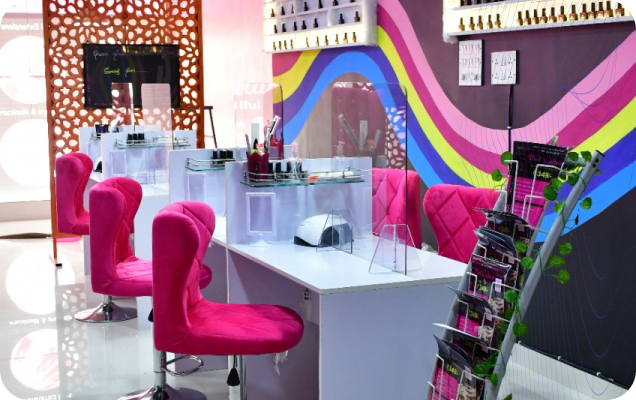
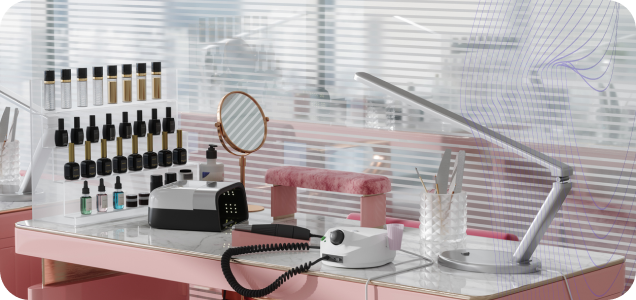
Use bright, natural lighting to create a welcoming and professional environment. Proper lighting is essential for detailed nail work and enhances the overall ambiance. Choose a color scheme that reflects your brand and creates a relaxing atmosphere. Soft, neutral colors are often preferred for a calming effect. Ensure ample storage space for tools, supplies, and personal items. Organized storage keeps the salon tidy and efficient.
Design the layout to facilitate easy cleaning and maintenance. Use materials that are durable and easy to sanitize.
6. Purchase Quality Equipment and Supplies
Investing in the equipment needed to start a nail salon is crucial for providing excellent service. Create a list of essential items, such as manicure tables, pedicure chairs, sterilizers, and nail polish. Choose reliable suppliers who offer durable, safe, and cost-effective products.
Invest in essential equipment such as manicure tables, pedicure chairs, nail dryers, and UV/LED lamps. Ensure the equipment is comfortable for customers and ergonomically designed for technicians. Purchase high-quality sterilization tools, including autoclaves and UV sterilizers, to maintain hygiene and prevent infections.
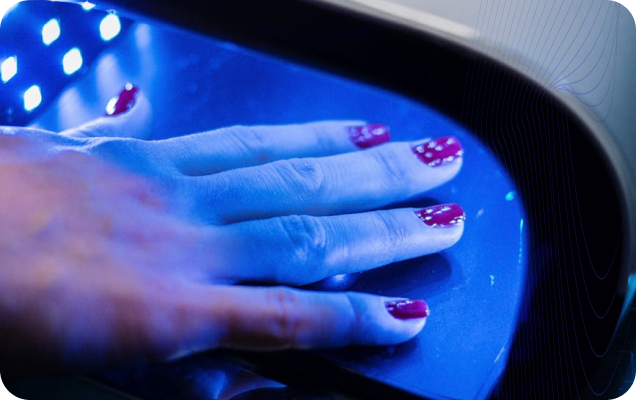
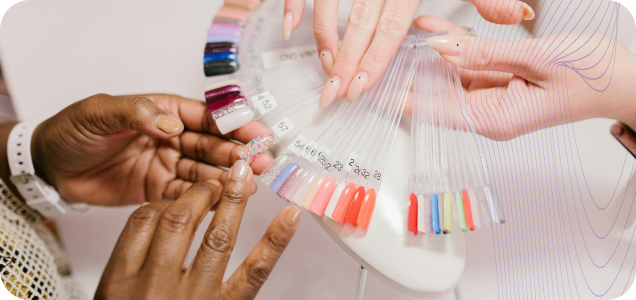
Stock a variety of high-quality nail products, including polishes, gels, acrylics, and nail art supplies. Choose reputable brands known for their durability and safety. Select comfortable and stylish furniture for your salon. Consider ergonomic chairs for technicians and plush seating for customers. Decorate the salon to create a relaxing and visually appealing environment.
Build relationships with reliable suppliers who offer quality products at competitive prices. Consider suppliers who provide ongoing support, such as training and product updates.
7. Hire Skilled and Professional Staff
Your staff's expertise and professionalism play a crucial role if you decide to open a nail salon. This is about your salon's reputation. That is why, recruit qualified nail technicians and support staff who are passionate about their work. Offer competitive salaries and benefits to attract top talent. Provide ongoing training to keep your team updated with the latest techniques and trends.
Create clear and detailed job descriptions for each position. Include required qualifications, responsibilities, and expectations. Use various recruitment methods, such as job boards, social media, and industry networks, to find qualified candidates. Attend job fairs and industry events to connect with potential employees.


Conduct thorough interviews to assess candidates' skills, experience, and cultural fit. Include practical tests to evaluate their technical abilities. Develop a comprehensive onboarding process to welcome new employees. Provide training on salon policies, procedures, and customer service standards.
Offer regular training sessions to keep your staff updated on the latest techniques, trends, and products. Encourage continuous learning and professional development. Provide competitive salaries and benefits, such as health insurance, paid time off, and performance bonuses. Create a positive work environment that fosters employee satisfaction and retention.
8. Develop a Pricing Strategy
Setting the right prices for your services is vital for profitability and returning the starting cost of starting a nail salon. Consider market rates, your costs, and the perceived value of your services. Ensure your pricing strategy is competitive yet allows for a healthy profit margin. Regularly review and adjust your prices based on market conditions and customer feedback.
Calculate your costs, including equipment, supplies, rent, salaries, and utilities. Ensure your prices cover these costs and provide a reasonable profit margin. Research the prices charged by competitors in your area. Aim to offer competitive pricing that reflects the quality and value of your services.


Consider the perceived value of your services. Higher prices can be justified if your salon offers unique or premium services that customers value. Incorporate promotions and discounts into your pricing strategy. Offer introductory rates, bundle deals, and seasonal discounts to attract new customers and encourage repeat business.
Regularly review your pricing strategy to ensure it remains competitive and profitable. Adjust prices based on changes in costs, market conditions, and customer feedback.
9. Create a Menu of Services
A diverse range of services caters to various customer preferences and needs. Offering basic manicures and pedicures, along with specialty treatments such as nail art, gel nails, and spa services is one of the steps to open a nail salon. Regularly update your service menu to include new trends and techniques, keeping your offerings fresh and appealing.
Offer essential services such as manicures, pedicures, nail extensions, and gel polish. Ensure these services are high quality and meet customer expectations. Introduce specialty services like nail art, 3D designs, paraffin treatments, and spa pedicures. These services can differentiate your salon and attract customers looking for unique experiences.


Create seasonal or themed services to attract customers during holidays and special occasions. For example, offer Valentine's Day nail art or holiday-themed manicures. Develop service packages that bundle popular treatments together at a discounted rate. This encourages customers to try multiple services and increases their overall spending.
Design an attractive and easy-to-read service menu. Include clear descriptions, pricing, and any special promotions. Ensure the menu reflects your brand's style and professionalism. Regularly seek feedback from customers on your service offerings. Use their suggestions to improve and expand your menu.
10. Implement a Nail Salon POS System
A POS (Point of Sale) system streamlines salon operations and enhances customer experience. Systems like ME-POS manage appointments, track sales, and handle inventory. They also offer features like customer relationship management and loyalty programs. Investing in a robust POS system improves efficiency and customer satisfaction.
Benefits of implementing nail salon POS systems include:
-
Appointment Management: A POS system allows you to schedule and manage appointments efficiently. It reduces booking errors and ensures optimal utilization of your staff's time.
-
Sales Tracking: Track sales and revenue in real time. A POS system provides detailed reports on daily, weekly, and monthly sales, helping you monitor your business's performance.
-
Inventory Management: Manage your inventory with ease. A POS system tracks stock levels, alerts you when supplies are low, and helps prevent overstocking or stockouts.
-
Customer Relationship Management: Build a database of customer information, including contact details, service history, and preferences. Use this information to personalize services and marketing efforts.
-
Loyalty Programs: Implement loyalty programs that reward customers for their repeat business. A POS system can track points and rewards, encouraging customer retention.
-
Payment Processing: Simplify payment processing with integrated payment options. A POS system can handle cash, credit cards, and digital payments, providing a seamless checkout experience.
Investing in a POS system will not significantly increase your nail salon start-up cost, as you need to pay for a monthly subscription of around $10-$20 only.

11. Invest in Marketing and Advertising
Effective marketing strategies are essential for a nail salon business start-up. Utilize both online and offline methods to promote your salon. Create engaging content for social media, run targeted ads, and collaborate with local influencers.
Offline strategies like flyers, local events, and partnerships can also boost your visibility. Create and maintain active profiles on social media platforms like Instagram, Facebook, and TikTok. Share engaging content, including photos of nail art, behind-the-scenes videos, and customer testimonials. Use hashtags and collaborate with influencers to reach a broader audience.


Develop a professional website that showcases your services, prices, and contact information. Include an online booking system to make it easy for customers to schedule appointments. Optimize your website for search engines to improve its visibility. Use relevant keywords, create high-quality content, and build backlinks to rank higher in search results.
Build an email list of customers and send regular newsletters with updates, promotions, and special offers. Personalize your emails to increase engagement and retention. Distribute flyers, business cards, and promotional materials in your local area. Partner with nearby businesses to cross-promote services and attract new customers.
Host events, such as grand openings, seasonal celebrations, or customer appreciation days, to attract new customers and build community relationships. Offer special promotions during these events to encourage attendance and sales.
12. Establish an Online Presence
A professional website and active social media profiles are crucial for a nail salon start-up as it builds your brand. Your website should include essential information like services, pricing, and contact details. Engage with customers on social media by sharing updates, promotions, and nail art inspiration.
Manage online reviews and maintain a positive reputation. Create a user-friendly and visually appealing website. Include information about your services, prices, location, and contact details. Incorporate an online booking system to facilitate appointments.


Optimize your website for search engines to improve its visibility. Use relevant keywords, create high-quality content, and build backlinks to rank higher in search results. Set up and maintain active profiles on social media platforms like Instagram, Facebook, and TikTok. Share engaging content, including photos of nail art, behind-the-scenes videos, and customer testimonials. Use hashtags and collaborate with influencers to reach a broader audience.
Regularly create and share valuable content that engages your audience. This can include blog posts, tutorials, customer stories, and promotions. Quality content builds trust and attracts new customers. Encourage satisfied customers to leave positive reviews on platforms like Google, Yelp, and Facebook. Respond to reviews promptly, addressing any concerns professionally. Positive reviews build your reputation and attract new customers.
Build an email list of customers and send regular newsletters with updates, promotions, and special offers. Personalize your emails to increase engagement and retention.
13. Focus on Customer Service
To open a nail salon business, provide excellent customer service, as it will help you to build a loyal clientele. Train your staff to provide friendly, attentive, and personalized service. Create a comfortable and relaxing environment for your customers. Address complaints promptly and professionally, turning negative experiences into positive ones.
Train your staff to greet customers warmly and provide attentive service. Encourage them to listen to customer needs and preferences and offer personalized recommendations. Create a relaxing and comfortable environment for your customers. Offer amenities like refreshments, comfortable seating, and soothing music to enhance their experience.


Ensure appointments run on time to respect your customers' schedules. If delays occur, communicate with customers and offer compensation, such as a discount on their next visit. Address customer complaints promptly and professionally. Listen to their concerns, apologize sincerely, and offer solutions. Turning negative experiences into positive ones can build customer loyalty.
Follow up with customers after their visit to thank them for their business and ask for feedback. Personalized follow-up messages show you value their patronage and are committed to their satisfaction. Implement loyalty programs that reward customers for their repeat business. Offer discounts, free services, or exclusive perks to loyal customers.
14. Offer Promotions and Loyalty Programs
«Promotions and loyalty programs» is a popular answer to «How to open a nail salon?». They encourage repeat business and reward long-term customers. Offer discounts, bundle deals, and referral incentives. Implement a loyalty program that offers points or rewards for each visit.
Attract new customers with introductory offers, such as a discount on their first visit or a free add-on service. Run promotions during holidays and special occasions, such as Valentine's Day, Mother's Day, or back-to-school season. Offer themed services or discounts to attract customers.


Create bundle deals that offer multiple services at a discounted rate. For example, offer a manicure and pedicure package or a nail art add-on with a gel polish service. Encourage customers to refer friends and family by offering referral incentives. Provide discounts or free services to both the referrer and the new customer.
Implement a loyalty program that rewards customers for their repeat business. Offer points for each visit that can be redeemed for discounts, free services, or exclusive perks. Run flash sales or limited-time offers to create urgency and attract customers. Promote these sales through email and social media to reach a wide audience.
15. Maintain High Standards of Cleanliness and Safety
Opening a nail salon checklist includes cleanliness and hygiene as paramount. Follow strict sanitation protocols for tools and workstations. Regularly disinfect surfaces and provide hand sanitizers for customers. Ensure your staff follows hygiene practices like wearing gloves and masks.
Establish and follow strict sanitation protocols for all tools and equipment. Sterilize reusable tools between clients and use disposable items where possible. Regularly disinfect all surfaces, including workstations, waiting areas, and restrooms. Use EPA-approved disinfectants to ensure thorough cleaning.
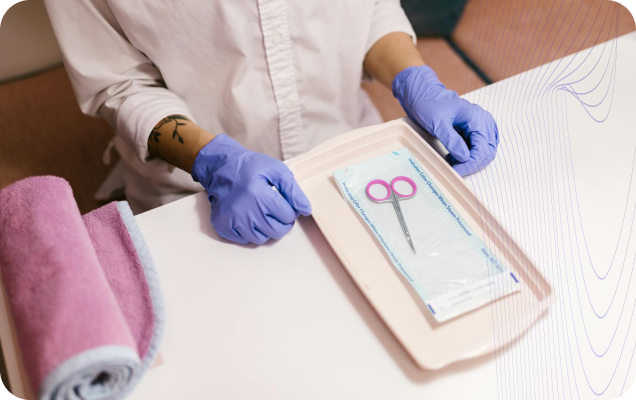

Provide hand sanitizers for customers and staff. Encourage frequent handwashing and the use of gloves for nail technicians. Ensure staff wear appropriate PPE, such as gloves and masks, to prevent the spread of infections. Provide training on proper use and disposal of PPE.
Maintain high standards of cleanliness throughout the salon. Ensure floors, windows, and mirrors are clean and free of dust and debris. Provide regular health and safety training for your staff. Ensure they understand and follow hygiene protocols and are aware of the latest health guidelines.
16. Stay Updated with Industry Trends
Keeping up with the latest nail industry trends, techniques, and products is essential for staying competitive in opening your own nail salon landscape. Attend trade shows, workshops, and training sessions. Follow industry publications and influencers. Introducing new services and products keeps your salon fresh and appealing to customers.
Attend industry trade shows and conferences to learn about the latest trends, products, and technologies. Network with industry professionals and gain insights into emerging trends. Participate in workshops and training sessions to enhance your skills and learn new techniques. Encourage your staff to attend training programs to keep their skills updated.


Subscribe to industry magazines, journals, and online publications. Stay informed about the latest trends, product launches, and best practices. Follow industry influencers and brands on social media platforms. Stay updated on new trends, techniques, and product reviews.
Listen to your customers' preferences and requests. They can provide valuable insights into emerging trends and popular services. Maintain relationships with product suppliers. They can provide information on new products, innovations, and industry trends.
17. Manage Your Finances Effectively
Effective financial management is crucial for your salon's sustainability and future return on the cost of opening up a nail salon. Create a budget and monitor your expenses closely. Keep track of your income and cash flow. Plan for seasonal fluctuations and unexpected expenses. Regularly review your financial performance and make necessary adjustments.
Create a detailed budget that outlines your expected income and expenses. Include all costs, such as rent, salaries, supplies, marketing, and utilities. Monitor your budget regularly and adjust as needed. Keep track of all expenses to ensure they are within budget. Use accounting software to manage your finances and generate reports.


Monitor your income and cash flow to ensure your business remains profitable. Track your revenue from services, retail sales, and promotions. Plan for seasonal fluctuations and unexpected expenses. Set aside funds for slow periods and emergencies.
Look for ways to control costs without compromising quality. Negotiate with suppliers, reduce waste, and optimize your operations. Regularly review your financial performance. Analyze your income statements, balance sheets, and cash flow statements. Identify areas for improvement and make necessary adjustments.
18. Gather and Act on Customer Feedback
Customer feedback is invaluable for identifying areas for improvement. Encourage customers to share their experiences through surveys, reviews, and comment cards. Analyze the feedback to understand their needs and preferences. Implement changes based on their suggestions to enhance your services and customer satisfaction.
Provide surveys and comment cards to gather feedback from customers. Ask about their satisfaction with services, staff, and the overall experience. Monitor online reviews on platforms like Google, Yelp, and Facebook. Respond to reviews promptly and professionally. Address any concerns and thank customers for their feedback.


Use social media to engage with customers and gather feedback. Encourage them to share their experiences and suggestions. Analyze the feedback to identify common themes and areas for improvement. Use this information to make data-driven decisions. Implement changes based on customer feedback. This could include introducing new services, improving customer service, or enhancing the salon environment. Follow up with customers to inform them of the changes made based on their feedback. Show appreciation for their input and commitment to improving their experience.
Conclusion
Steps to starting a nail salon require careful planning and dedication. By following these 18 comprehensive tips on how to start a nail salon business, you can build a solid foundation for a successful business:
-
Conduct thorough market research.
-
Create a strategic business plan.
-
Choose the right location.
-
Obtain necessary licenses and permits.
-
Design your salon layout.
-
Purchase quality equipment and supplies.
-
Hire skilled and professional staff.
-
Develop a pricing strategy.
-
Create a diverse menu of services.
-
Implement a robust POS system.
-
Invest in marketing and advertising.
-
Establish a strong online presence.
-
Focus on excellent customer service.
-
Offer promotions and loyalty programs.
-
Maintain high standards of cleanliness and safety.
-
Stay updated with industry trends.
-
Manage your finances effectively.
-
Gather and act on customer feedback.
If you ask, «How much does it cost to open a nail salon through these tips?» the answer is: it will vary, but you can expect to invest between $50,000 and $100,000 to cover market research, business planning, location setup, licensing, equipment, staff hiring, marketing, and other essential expenses.
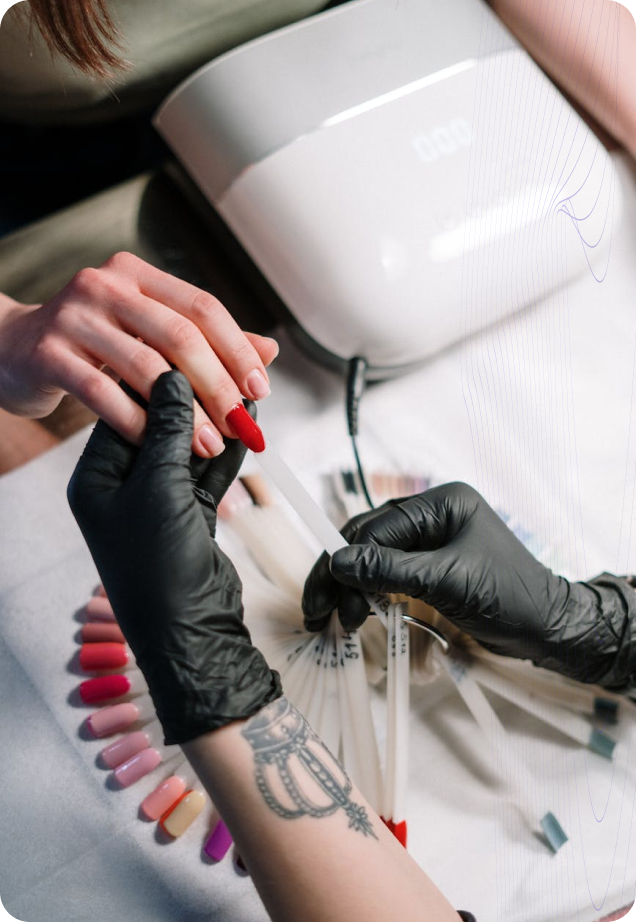
View more
Related Articles
View more




































